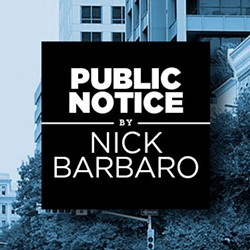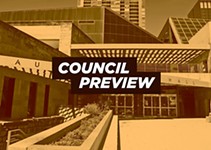Public Notice: No Fireworks, but a Bombshell
City Council, AISD Board adjourn for summer with work left to do
By Nick Barbaro, Fri., June 30, 2017

And so the doldrums begin. Both City Council and the AISD Board took care of business this week (sort of), and are now on their summer hiatus, heading into July without the pre-holiday fireworks that might have been expected from their final meetings.
The AISD Board started things off Monday evening with a final discussion and vote on a massive bond proposal to go to the November ballot – with money going everywhere in the district, but highlighted by a controversial plan to move two high schools on the Eastside to get the Liberal Arts and Sciences Academy its own facility, away from the largely minority LBJ High.
In the end, with a new Mueller middle school added to bring the bond package up to $1.05 billion (see "Billion-Dollar AISD Bond Goes to Vote in November," June 30), the proposal passed unanimously, with no substantive discussion. Even Trustee Ted Gordon seemed resigned to the fact that this is likely the best package the board could pass, and that voters may approve in November. He pledged full support for the bond package, and in that spirit, declined to rehash any of the arguments he had made previously about certain of its components. So let me do that for him a little bit – because sadly, Monday's AISD Board vote marked the end of a decades-long integration initiative.
Last week Gordon railed against the fact that the switch left three high schools in his district, and at every one, "we're well over 90% black and brown, [and] well over 80% and heading into 90% in terms of socioeconomically underprivileged." That's stark, but it's the result of conscious choices by the board and administrations. The co-location of LASA on the Eastside with LBJ (and earlier Johnston) was a conscious move to do the opposite, and in early discussion on this move, Gordon challenged the board to acknowledge that moving LASA away from LBJ will constitute an "unprecedented failure in terms of the ability of the different kind of factors and sectors of our community here in Austin to get along. ... What we do, when we move LASA out of LBJ, is to admit defeat. ... Is this the model for the way that we do diversity, we do social justice, and we do desegregation in this district?"
So, yeah, this may be the best bond we can do, and I guess we're all okay with that, but still ...
On a brighter note (??), City Council got some unexpected news Wednesday, in the very last of their seemingly hundreds of special meetings, work sessions, and briefings on various aspects of CodeNEXT, the land development code rewrite: You know all that code and mapping you've been trying to decipher for the past months? Well, never mind all that; we've got a whole new idea, that's a lot simpler and more intuitive, and won't use any of the terminology and definitions that you've been struggling over in the first draft of the code. Umm, thanks, but where was this a year ago?
It was an idea first rolled out in the joint Planning/Zoning and Platting Commission meeting the evening before, and it has met with considerable, if guarded, enthusiasm: Having heard the public feedback that the first draft code was too complex, and its split between "transect" and "non-transect" zones too stark and strange, staff and consultants have indeed taken that to heart.
The result came in a truly bizarre presentation from Opticos consultants Peter Park and John Miki – the first half explaining how the transect and non-transect zones will be formatted to look more similar to each other; the second half explaining that they'll be doing away with the transect and non-transect zones and code altogether, and replacing them with a new unified set of codes. It was as though they didn't come up with the idea until after they'd already done the first half of the slide show. Indeed, Planning and Zoning Assistant Director Jerry Rusthoven confirmed, "This is an idea that just came up in the last couple of days."
It's a radical enough departure that all concerned took turns restating the proposition in as simple terms as possible, to make sure Council understood the import of what was being proposed: Acting City Manager Elaine Hart wanted to make clear: "As we move forward in the draft, we will not see the transect and non-transect codes." And Rusthoven repeated that the new draft will "not maintain the transect and non-transect zones" and will "get rid of the nomenclature of T zones and non-T zones." Replacing them will be a simplified list of R1 through R4, each allowing the indicated number of residential units by right per lot, plus RM1 through RM6 for increasingly dense multifamily residential. The idea is so new that "we haven't had a chance to tackle the commercial zones" at all, said Rusthoven. With few clues to work on and given the general distaste everywhere for the first draft, Council gave the new direction their blessing, and sent the planners off to figure out what it consists of by August.
So of course, what everyone's talking about as the second draft – or version 2.0 – will functionally be more like a first draft of a new code, with discussion and revision now to be compressed into a much shorter time frame, and as yet no plans for another public comment opportunity for the largely rewritten draft. And I guess we're all okay with that, too.
In their last half-hour, Council settled all questions regarding neighborhood plans, small area plans, parking, flooding, environmental issues, infrastructure, and Imagine Austin. And everyone went home happy.
Send gossip, dirt, innuendo, rumors, and other useful grist to [email protected].
Got something to say on the subject? Send a letter to the editor.












